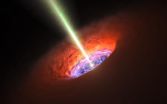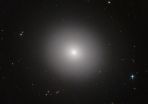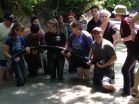Up to now only weak magnetic fields far from black holes -- several light-years away -- had been probed [1]. In this study, however, astronomers from Chalmers University of Technology and Onsala Space Observatory in Sweden have now used ALMA to detect signals directly related to a strong magnetic field very close to the event horizon of the supermassive black hole in a distant galaxy named PKS 1830-211. This magnetic field is located precisely at the place where matter is suddenly boosted away from the black hole in the form of a jet.
The team measured the strength of the magnetic field by studying the way in which light was polarised, as it moved away from the black hole.
"Polarisation is an important property of light and is much used in daily life, for example in sun glasses or 3D glasses at the cinema," says Ivan Marti-Vidal, lead author of this work. "When produced naturally, polarisation can be used to measure magnetic fields, since light changes its polarisation when it travels through a magnetised medium. In this case, the light that we detected with ALMA had been travelling through material very close to the black hole, a place full of highly magnetised plasma."
The astronomers applied a new analysis technique that they had developed to the ALMA data and found that the direction of polarisation of the radiation coming from the centre of PKS 1830-211 had rotated [2]. These are the shortest wavelengths ever used in this kind of study, which allow the regions very close to the central black hole to be probed [3].
"We have found clear signals of polarisation rotation that are hundreds of times higher than the highest ever found in the Universe," says Sebastien Muller, co-author of the paper. "Our discovery is a giant leap in terms of observing frequency, thanks to the use of ALMA, and in terms of distance to the black hole where the magnetic field has been probed -- of the order of only a few light-days from the event horizon. These results, and future studies, will help us understand what is really going on in the immediate vicinity of supermassive black holes."
INFORMATION:
Notes
[1] Much weaker magnetic fields have been detected in the vicinity of the relatively inactive supermassive black hole at the centre of the Milky Way. Recent observations have also revealed weak magnetic fields in the active galaxy NGC 1275, which were detected at millimetre wavelengths.
[2] Magnetic fields introduce Faraday rotation, which makes the polarisation rotate in different ways at different wavelengths. The way in which this rotation depends on the wavelength tells us about the magnetic field in the region.
[3] The ALMA observations were at an effective wavelength of about 0.3 millimetres, earlier investigations were at much longer radio wavelengths. Only light of millimetre wavelengths can escape from the region very close to the black hole, longer wavelength radiation is absorbed.
More information
This research was presented in a paper entitled "A strong magnetic field in the jet base of a supermassive black hole" to appear in Science on 17 April 2015
The team is composed of I. Martí-Vidal (Onsala Space Observatory and Department of Earth and Space Sciences, Chalmers University of Technology, Sweden), S. Muller (Onsala Space Observatory and Department of Earth and Space Sciences, Chalmers University of Technology, Sweden), W. Vlemmings (Department of Earth and Space Sciences and Onsala Space Observatory, Chalmers University of Technology, Sweden), C. Horellou (Department of Earth and Space Sciences, Chalmers University of Technology, Sweden) and S. Aalto (Department of Earth and Space Sciences, Chalmers University of Technology, Sweden).
The Atacama Large Millimeter/submillimeter Array (ALMA), an international astronomy facility, is a partnership of ESO, the US National Science Foundation (NSF) and the National Institutes of Natural Sciences (NINS) of Japan in cooperation with the Republic of Chile. ALMA is funded by ESO on behalf of its Member States, by NSF in cooperation with the National Research Council of Canada (NRC) and the National Science Council of Taiwan (NSC) and by NINS in cooperation with the Academia Sinica (AS) in Taiwan and the Korea Astronomy and Space Science Institute (KASI).
ALMA construction and operations are led by ESO on behalf of its Member States; by the National Radio Astronomy Observatory (NRAO), managed by Associated Universities, Inc. (AUI), on behalf of North America; and by the National Astronomical Observatory of Japan (NAOJ) on behalf of East Asia. The Joint ALMA Observatory (JAO) provides the unified leadership and management of the construction, commissioning and operation of ALMA.
ESO is the foremost intergovernmental astronomy organisation in Europe and the world's most productive ground-based astronomical observatory by far. It is supported by 16 countries: Austria, Belgium, Brazil, the Czech Republic, Denmark, France, Finland, Germany, Italy, the Netherlands, Poland, Portugal, Spain, Sweden, Switzerland and the United Kingdom, along with the host state of Chile. ESO carries out an ambitious programme focused on the design, construction and operation of powerful ground-based observing facilities enabling astronomers to make important scientific discoveries. ESO also plays a leading role in promoting and organising cooperation in astronomical research. ESO operates three unique world-class observing sites in Chile: La Silla, Paranal and Chajnantor. At Paranal, ESO operates the Very Large Telescope, the world's most advanced visible-light astronomical observatory and two survey telescopes. VISTA works in the infrared and is the world's largest survey telescope and the VLT Survey Telescope is the largest telescope designed to exclusively survey the skies in visible light. ESO is a major partner in ALMA, the largest astronomical project in existence. And on Cerro Armazones, close to Paranal, ESO is building the 39-metre European Extremely Large Telescope, the E-ELT, which will become "the world's biggest eye on the sky".
Links
Photos of ALMA: http://www.eso.org/public/images/archive/search/?adv=&subject_name=Atacama%20Large%20Millimeter/submillimeter%20Array
Contacts
Ivan Marti-Vidal
Onsala Space Observatory
Onsala, Sweden
Tel: +46 31 772 55 57
Email: ivan.marti-vidal@chalmers.se
Richard Hook
ESO, Public Information Officer
Garching bei München, Germany
Tel: +49 89 3200 6655
Cell: +49 151 1537 3591
Email: rhook@eso.org






